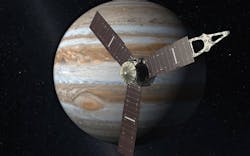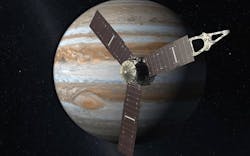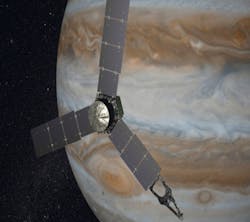Aerospace innovators contribute technology to, help place Juno spacecraft into orbit around Jupiter
DENVER, 5 July 2016. After a five-year, 1.76-billion-mile journey, NASA's Juno spacecraft, built by Lockheed Martin (NYSE:LMT), was placed into a large, elliptical polar orbit around Jupiter. The spacecraft's flight operations were controlled by a joint team at Lockheed Martin's Mission Support Area near Denver, and NASA's Jet Propulsion Laboratory (JPL) in Pasadena, California.
"Tonight, 540 million miles away, Juno performed a precisely choreographed dance at blazing speeds with the largest, most intense planet in our solar system," describes Guy Beutelschies, director of interplanetary missions at Lockheed Martin Space Systems. "Since launch, Juno has operated exceptionally well, and the flawless orbit insertion is a testament to everyone working on Juno and their focus on getting this amazing spacecraft to its destination. NASA now has a science laboratory orbiting Jupiter."
Final commands to ready Juno for the orbit insertion were sent to the spacecraft, putting it into autopilot. At 9:18 p.m. MDT on 4 July 2016, those commands fired the large main engine for a 35-minute burn that slowed the spacecraft by 1,212 mph. It allowed the craft to be captured by Jupiter's massive gravity and placed into a large elliptical polar orbit around the planet that is initially 53 days long. In the following months, the orbit will be reduced to 14 days long for science observations.
The Juno spacecraft was launched aboard a United Launch Alliance Atlas V 551 rocket on 5 Aug. 2011 from Cape Canaveral, Florida. JPL manages the Juno mission for the principal investigator, Dr. Scott Bolton, of Southwest Research Institute in San Antonio. Juno is part of NASA's New Frontiers Program, which is managed at NASA's Marshall Space Flight Center in Huntsville, Alabama, for NASA's Science Mission Directorate. Lockheed Martin Space Systems built the spacecraft. The California Institute of Technology in Pasadena manages JPL for NASA.
Aerojet Rocketdyne, a subsidiary of Aerojet Rocketdyne Holdings Inc. (NYSE:AJRD), provided 26 propulsion devices and six pressurant tanks aboard the United Launch Alliance (ULA) Atlas V rocket during its 2011 launch, as well as 12 propulsion devices on the spacecraft during its five-year journey through space. Aerojet Rocketdyne propulsion aboard the Atlas V included an RL10A-4-2 upper-stage engine that provided 22,300 lbf thrust; five solid rocket boosters that offered an average of 250,000 lbf of thrust each; eight retro-rockets for the Centaur separation from the Atlas common core booster; and 12 MR-106 monopropellant hydrazine thrusters on the Atlas V Centaur upper stage that provided roll, pitch and yaw control, as well as settling burns for the upper-stage main engines.
The Juno spacecraft includes 12 Aerojet Rocketdyne MR-111C 1.0 lbf monopropellant hydrazine Rocket Engine Assemblies that have provided attitude control for the spacecraft throughout its journey, as well as during insertion into Jupiter’s orbit. ARDÉ, a subsidiary of Aerojet Rocketdyne based in New Jersey, provides the pressure vessels on the first and second stages on the launch vehicle.
“Juno has traveled 1.74 billion miles over the course of nearly five years to get to Jupiter – and our propulsion systems were there the entire time, helping the spacecraft arrive from launch through orbit insertion,” explains Aerojet Rocketdyne CEO and President Eileen Drake. “Aerojet Rocketdyne is honored to play such a critical role in the study of our solar system’s largest planet, and to know our diverse propulsion capabilities once again delivered with 100 percent mission success. Congratulations to everyone involved in this mission.”
A team of Harris Corporation (NYSE:HRS) employees supported NASA with critical communications and monitoring connectivity with the Juno spacecraft as it was successfully inserted into orbit around Jupiter. Juno will conduct a study of Jupiter's composition, gravity field, magnetic field, and polar magnetosphere. It will also search for clues about how the planet formed, including whether it has a rocky core, the amount of water present within the deep atmosphere, how its mass is distributed, and the behavior of its surface winds, which can reach speeds of 384 miles per hour.
More than 100 Harris employees provided operations, maintenance and engineering services for the Deep Space Network (DSN) at the Jet Propulsion Laboratory (JPL) and NASA. DSN provides connectivity with the spacecraft and the instruments that collect the scientific data it gathers. DSN’s international communications complexes support interplanetary, robotic spacecraft missions as they conduct radio, radar, and astronomy observations of the solar system and beyond. In addition to Juno, DSN-supported missions include those of Voyager 1 and 2, the Mars Exploration Rover Project, Curiosity, and the Cassini Saturn mission.
Harris operates and maintains seven large antennas for the DSN, as well as multiple network and communications systems, several network operations centers, and facilities for testing, logistics, and maintenance and repair. The company also provides maintenance, operations and engineering support for JPL’s Goldstone, California, complex.
“Harris and the DSN have been preparing for Jupiter Orbit Insertion for well over a year to ensure the success of this mission,” says Carl D’Alessandro, president, Harris Critical Networks. “Harris has supported most major U.S. space programs since the 1960s. Today, we continue to supply the next-generation technologies and services that are helping NASA better understand our planet, our solar system and what lies beyond.”
Juno is the first mission dedicated to the study of the planet’s interior to learn more about its origins, structure, atmosphere and magnetosphere. The Juno mission is designed to give scientists a better understanding of Jupiter’s origin and evolution. The spacecraft will orbit Jupiter 37 times over the course of 20 months, mapping the planet’s magnetic and gravity fields, determining the abundance of water vapor in the planet’s atmosphere and studying the polar magnetosphere and Jovian aurora. The primary science goal is to understand how Jupiter formed. Juno will travel through the previously unexplored region above the planet’s poles, collecting the first images from that region, along with data about electromagnetic forces and high-energy particles in the harsh radiation belt environment of Jupiter’s inner magnetosphere.
NASA's Jet Propulsion Laboratory in Pasadena, California, manages the Juno mission for the principal investigator, Dr. Scott J. Bolton of Southwest Research Institute. Juno is part of NASA's New Frontiers Program, which is managed at NASA's Marshall Space Flight Center in Huntsville, Alabama, for NASA's Science Mission Directorate.
Jupiter is the solar system's largest planet, more than two-and-a-half times as massive as all of the other planets combined. Juno will conduct an in-depth study of the giant gas like no other mission before. The mission's primary goal is to improve our understanding of the formation and evolution of the planet and our solar system. Over the next 20 months, mission scientists will investigate the planet's origins, interior structure, deep atmosphere, and magnetosphere.1
The Juno spacecraft, which entered the orbit of Jupiter on 4 July 2016, will for the first time peer below the dense cover of clouds to answer questions about the gas giant and the origins of our solar system.
Juno's primary goal is to reveal the story of Jupiter's formation and evolution. Using long-proven technologies on a spinning spacecraft placed in an elliptical polar orbit, Juno will observe Jupiter's gravity and magnetic fields, atmospheric dynamics and composition, and evolution.
Launch - August 5, 2011
Deep Space Maneuvers - August/September 2012
Earth flyby gravity assist - October 2013
Jupiter arrival - July 4, 2016
Spacecraft will orbit Jupiter for 20 months (37 orbits)
End of mission (deorbit into Jupiter) - February 2018
Scientific Instrument(s)
- Gravity Science
- Magnetometer (MAG)
- Microwave Radiometer (MWR)
- Jupiter Energetic Particle Detector Instrument (JEDI)
- Jovian Auroral Distributions Experiment (JADE)
- Waves
- Ultraviolet Imaging Spectrograph (UVS)
- Jovian Infrared Auroral Mapper (JIRAM)
- JunoCam
Search the Aerospace & Defense Buyer's Guide
You might also like:
Subscribe today to receive all the latest aerospace technology and engineering news, delivered directly to your e-mail inbox twice a week (Tuesdays and Thursdays). Sign upfor your free subscription to the Intelligent Inbox e-newsletter at http://www.intelligent-aerospace.com/subscribe.html.
Connect with Intelligent Aerospace on social media: Twitter (@IntelligentAero), LinkedIn,Google+, and Instagram.
Intelligent Aerospace
Global Aerospace Technology NetworkIntelligent Aerospace, the global aerospace technology network, reports on the latest tools, technologies, and trends of vital importance to aerospace professionals involved in air traffic control, airport operations, satellites and space, and commercial and military avionics on fixed-wing, rotor-wing, and unmanned aircraft throughout the world.




